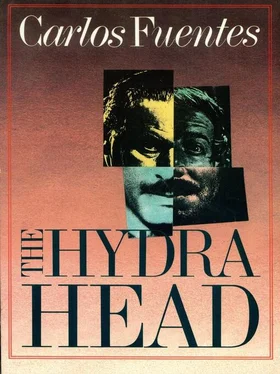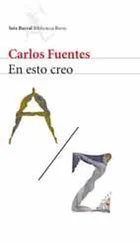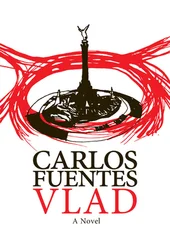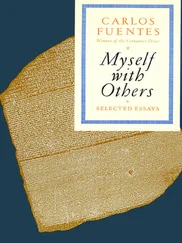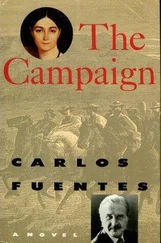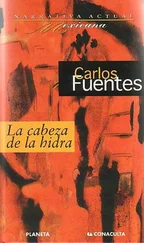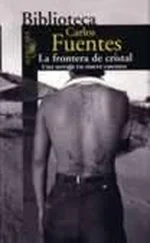“Buried, but also exhumed.”
I was distracted by the San Sebastian above the fireplace, a good example of sixteenth-century colonial painting. Felix’s face may have resembled Velázquez, but his body was that of the martyr — with words as arrows. Deliberately, I returned to my chair and again buried my face in my hands.
“You know, I did a little work myself, Felix. Everyone in this country uses his influence, that’s the law of the land. So I was given permission to exhume the body buried in your name.”
Felix grabbed me by the shoulders. “Who is it?”
I unclasped my hands and stared into his eyes. “A young Palestinian. A schoolteacher in one of the occupied territories. He fell in love with Sara Klein. He was tortured. The Director General’s agents located him and told him Sara was in Mexico with Bernstein, the man responsible for torturing him and his mother. They told him that Sara was Bernstein’s lover. The boy went mad. An impassioned Palestinian is passion itself, Felix. The Director General got false papers for him, smuggled him into Jordan, and from there the boy flew to Mexico. Maybe he wanted to kill Sara, or Bernstein, or both, I don’t know. He didn’t have the chance. They killed him first and placed him in a cell at the Military Camp, saying it was you, unconscious. You know the rest of the story.”
Felix released me. “Jamil.”
“That’s what Sara called him on the recording. His name was Isam Al-Dibi. He looked quite a bit like you. He would have been the ideal murderer of Sara Klein. But the Director General didn’t see that far ahead. You can’t have everything. He had enough on his mind following you to get the ring. He didn’t get it. That’s what’s important.”
“But he did find out about you and the organization, everything that…”
“I wanted him to find out. I wanted it because it’s important for both sides to know of our existence. The rule of political discourse is duplicity. That of diplomatic discourse multiplicity. Espionage is the combination of the two, both double and multiple.”
Felix dropped into the chair beside mine, as if to interrupt a conversation about events that were more exhausting to listen to than to have lived. In a daze, he stared about the room, studying the antique mirrors, the coffers with iron corners and iron keyholes, the rich marquetry, the molding, the ironwork and inlay, the hand-turned table legs and chairs of this mansion I’d bought from the heirs of an old millionaire named Artemio Cruz.
Finally he spoke, his voice as hollow as that of the man he unconsciously imitated. “Then the Director General murdered Jamil.”
“Isam Al-Dibi, yes.”
“But he was a Palestinian, a man who suffered…”
“I told you that no one has a monopoly on violence. Or injustice. Much less, morality.”
He stared at me absently: “How do you know all this, the Director General’s plans, Jamil’s death…?”
I hesitated. I was afraid of my answer. But for every subjective reason, even the most objective reasons, I was compelled to tell Felix Maldonado the truth. “Angelica told me. You know how she was. Much too nervous. She couldn’t bear feeling guilty. Even less, thinking she’d failed. She told me for one reason: her scorn for Rossetti. She talked a lot. You know how she was.”
“ Why did you want both sides to know about you? I don’t think they’re frightened. They know we’re a small group, pygmies alongside them.”
“Exactly. They will think we’re less significant than we really are, or will be. They will continue to underestimate us.”
“In spite of the fact that you ended up with the ring?”
“Yes. They’re convinced it’s of no value to us. First, because we know the secrets it contains. Second, because they don’t think we’re capable of deciphering its contents. So they’ll go through the same routine, and we’ll win a second time.”
Felix didn’t seem convinced. “That’s what Trevor said in Houston. I can imagine what was in the ring. But how did you decipher the information, if you did decipher it? There’re a lot of things you haven’t told me.”
I laughed. “Felix, you have to have everything explained to you. You don’t figure out anything for yourself, because you’re too wrapped up in yourself. When you get over that, you’ll be a really good agent.”
“Who said I want to be one?” He was laughing at me.
I ignored his impertinence. Felix deserved a little self-congratulation, and that would allow me to slip into a neutral topic. He still held the pistol, but it was a toy in his hand.
“It’s a devilishly ingenious technique,” I explained, and invited him to go with me to the chapel.
I WALKED to a bookshelf and pressed the brittle spine of my folio edition of Timon of Athens; the shelf swung upon its hinges, revealing a passageway to the ancient chapel of this colonial mansion. Felix followed, still carrying the pistol. I closed the concealed door behind us and turned on the lights in the tiny whitewashed oratory whose only furnishing was a metal stand.
The floor was paved with red volcanic rock; the wooden altar was painted white, with strips of gold molding. Above the reliquary and the tabernacle hung a painting of Our Lady of Guadalupe.
I opened the tabernacle and removed the water-clear stone from Bernstein’s ring. Holding it between thumb and index finger, I showed it to Felix. “Inside this stone are two hundred images reduced to the size of pinpoints. Each one is printed on extremely thin film of high contrast and high photosensitive resolution. But these are not simply photographs that record the differing light intensities reflecting from the object, they’re holograms that retain information about all phases of the light waves emanating from the object photographed. In contrast to normal film, if the hologram is cut or blemished, it retains the image of the whole in each portion of the film. This is because the light recorded is not located in one area of the film but is disseminated throughout the space between the object and the hologram.”
I placed Bernstein’s stone on the revolving top of the metal stand and turned off the lights. I returned to the altar and asked Felix to stand beside me. From the reliquary I removed an electronic control sensitive to the touch of my fingers. I warned Felix not to look toward the light projected from behind us toward precise pinpoints in the ring as it rotated in response to my controls. “What’s beautiful about this is that since the prints are made by laser beams, they can be re-created only by light projected from another laser. Look.”
I pressed the control and a ray of light as thin as a razor’s edge beamed from the left eye of Our Lady of Guadalupe to penetrate the surface of the ring. I pressed the control for rotation.
What we saw on the whitewashed wall was the virtual re-creation, in color and three dimension, of expanses of land photographed from the air. Each image bore the name of the region where it was located, followed immediately — with hallucinatory reality, seemingly so close one could reach out and touch them — by images of the limestone rock corresponding to the region: living reproductions of the electric, magnetic, gravitational, and seismological records of the subsurface; refractory readings of high-velocity beds; pressures and temperatures; holograms of the stereographic projections of the beds and the mathematical calculation of the quantity of fluid each contained: a splendid and frightening portrait of subterranean Mexico, the technological descent of the laser into the mythological hell of Mictlan, an ebullient photograph of the arteries, intestines, and nerve system of a quadrant of land explored meter by meter, as if plumbed by the hundred horrifying eyes of Argus.
Читать дальше
